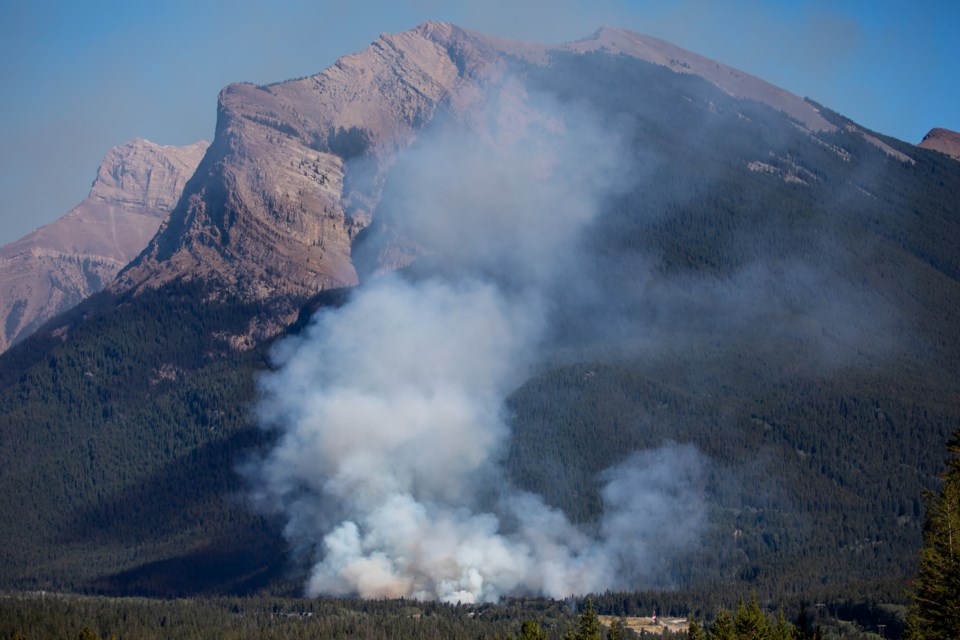KANANASKIS COUNTRY – A wildfire started by lit garbage was burning out of control in Bow Valley Provincial Park between Seebe and the Trans-Canada Highway Monday afternoon (Aug. 14).
The fire, first reported around 3:20 p.m. Monday (Aug. 14), has burned about 0.01 hectares, according to Alberta Wildfire, which classified the fire as under control shortly after due to early response from fire crews.
“There’s always a risk that something could escape but we’re not concerned at this time. It does appear to be contained to that very localized area and we should be able to extinguish it,” said Josee St-Onge, Alberta Wildfire information officer.
The fire is located in a loop off Bow Valley Park Street, near the Canadian Rockies Outdoor Learning Centre and southwest of Bow Valley Campground.
There is no risk to public safety or nearby structures at this time, said St-Onge. Exshaw Fire-Rescue and Nakoda Emergency Services are both involved in response.
“Firefighters were able to get to it very quickly, so that’s usually the key in controlling a wildfire is to be able to respond to it quickly and keep it at a very small size, and that luckily was the case here,” said St-Onge.
About 20 kilometres east, another wildfire was reported around the same time, southwest of Mînî Thnî, off the Trans-Canada Highway on Îyârhe (Stoney) Nakoda First Nation. The size of that fire was about 0.03 hectares as of 5:30 p.m. and is also classified as under control.
Both fires, which are in or near the Calgary Forest Area (CFA), are under investigation. The blaze south of Seebe is in a small area outside the boundaries of the CFA but is surrounded by it.
The northern portion of the CFA includes Canmore, Kananaskis Country and the MD of Bighorn. As of Aug. 14, the average fire danger across the CFA was rated extreme.
“The forecast is calling for temperatures in the low to mid-thirties with low humidity for the next several days with no anticipated precipitation,” reads an Alberta Wildfire update. “These conditions will continue to increase the wildfire danger.”
St-Onge said a drying trend over the past week has driven up fire danger, which is more extreme in the southern portion of the CFA, where a fire ban is currently in place. North of Highway 541, a fire advisory exists for the rest of the region.
“That reflects a little bit of the conditions that we see on the ground,” said St-Onge. “But overall, conditions are very dry and a fire can start very easily and spread very quickly, so it’s very important for people to be careful, follow fire bans that are in place, and even if there is no fire ban and they are allowed to have a campfire, to make sure it’s a safe one by keeping it small, always watching it and making sure to fully extinguish it when they’re done.”
The blazes started today are the only two active wildfires in the CFA, which has responded to 64 wildfires this season, burning a total of about 6.11 hectares.
In Alberta, there are 89 active wildfires. So far this year, there have been 971 wildfires in the province.
While wildfire has been minimal in the CFA this season, St-Onge said risk typically climbs as the summer stretches on, making it all the more important that people continue doing their part in preventing human-caused wildfires.
In nearby Banff National Park, the fire rating was considered high as of Aug. 14. Meanwhile, Kootenay and Yoho national parks are both under a fire ban due to elevated fire risk.
The Outlook has reached out to Exshaw-Fire Rescue and Nakoda Emergency Services for more details and will update this story.
The Local Journalism Initiative is funded by the Government of Canada. The position covers Îyârhe (Stoney) Nakoda First Nation and Kananaskis Country.



